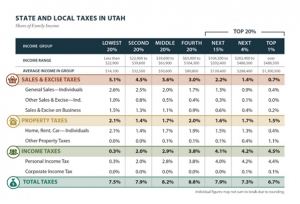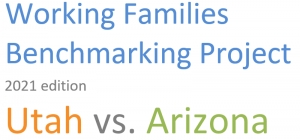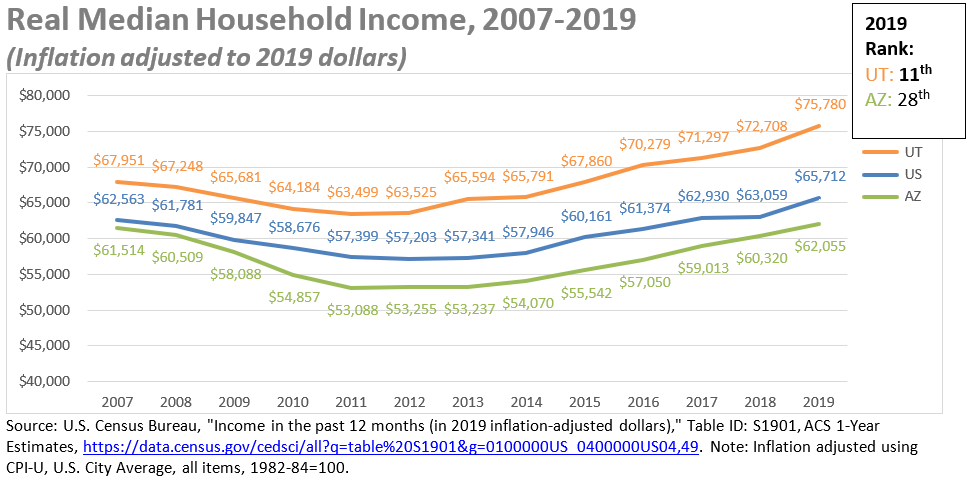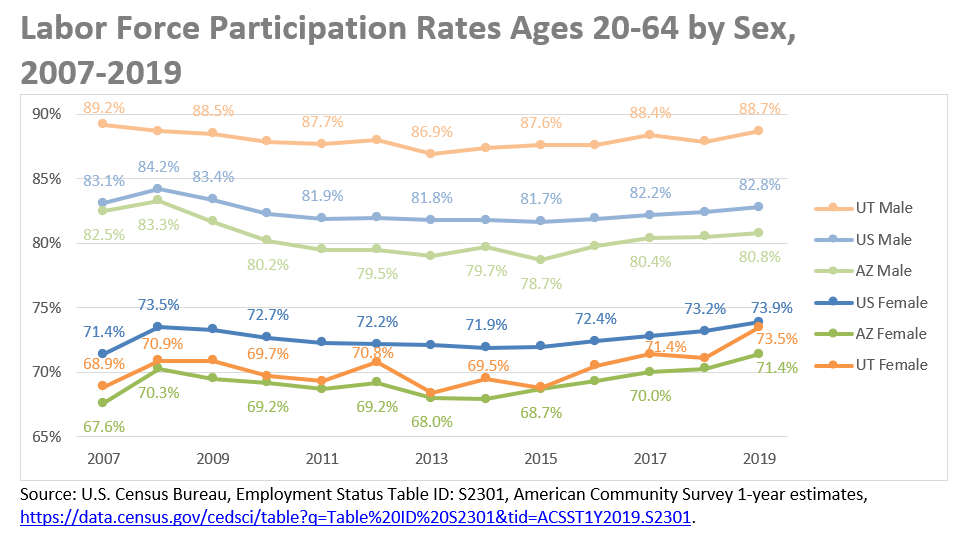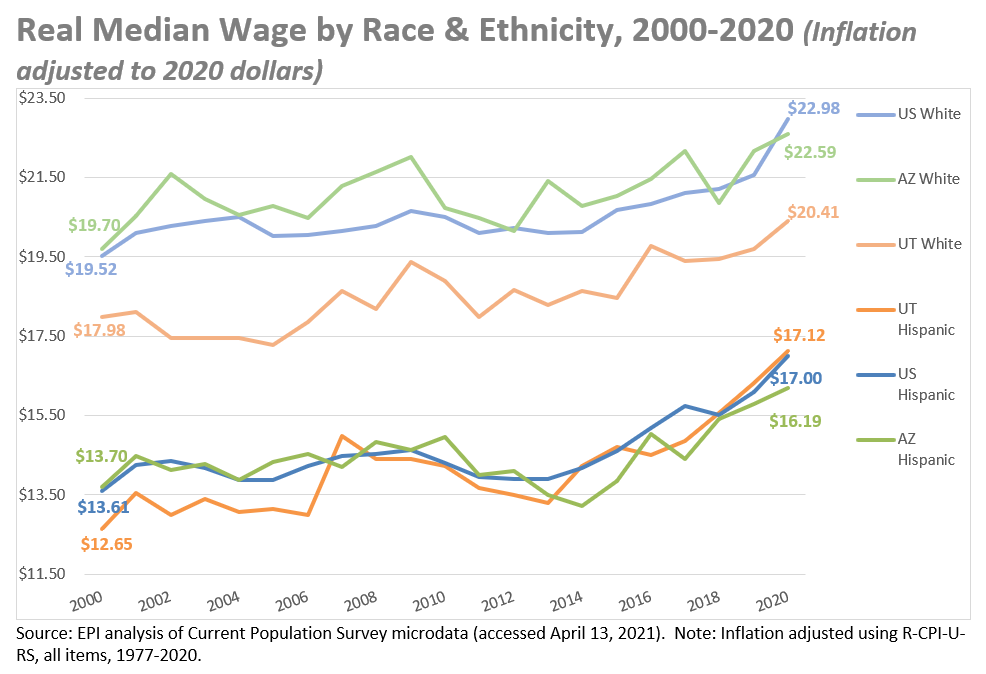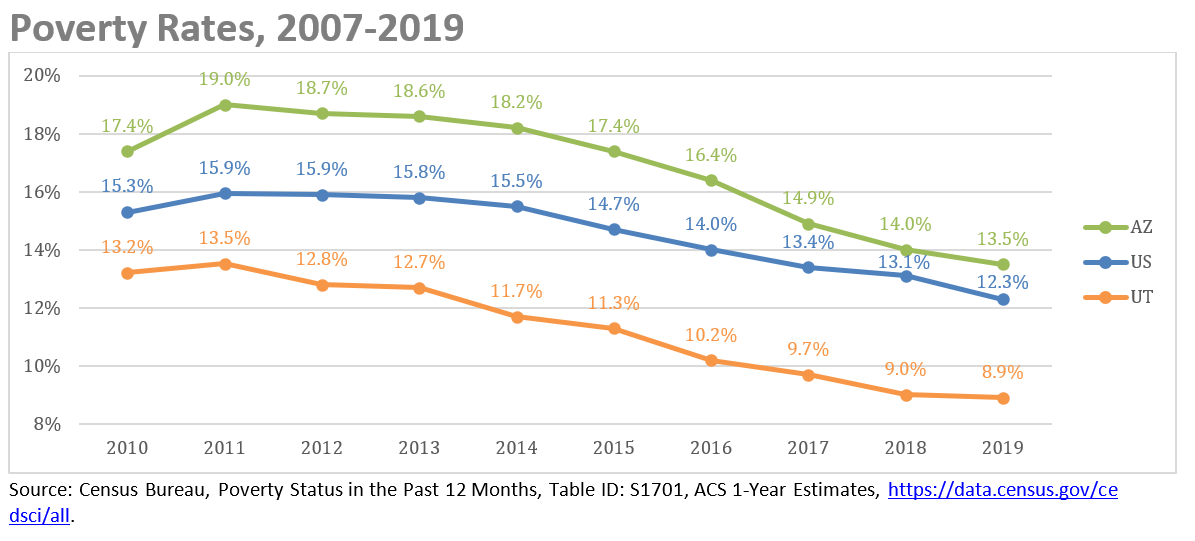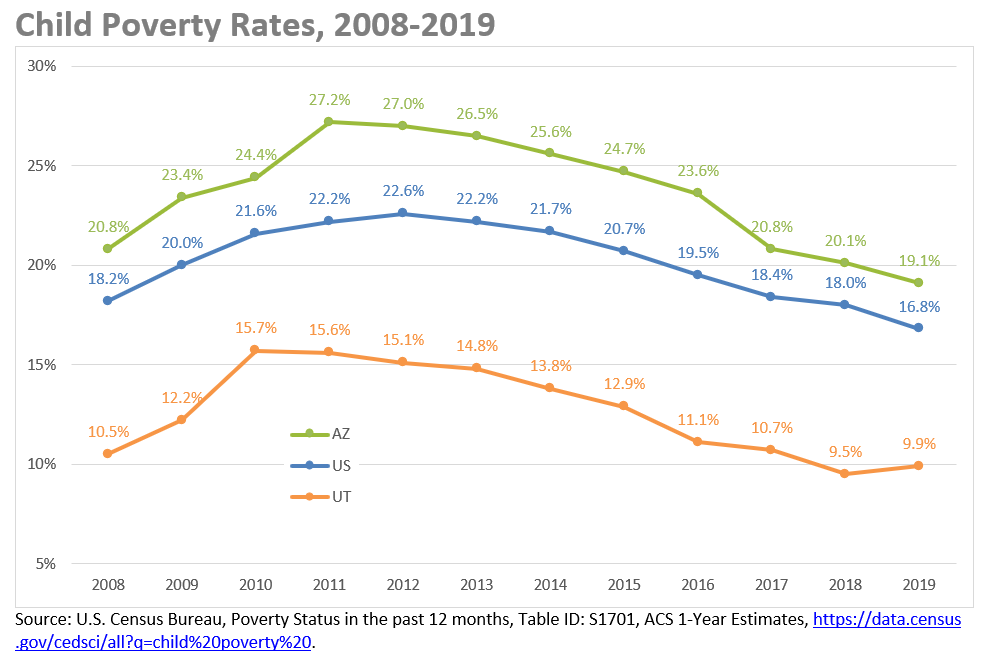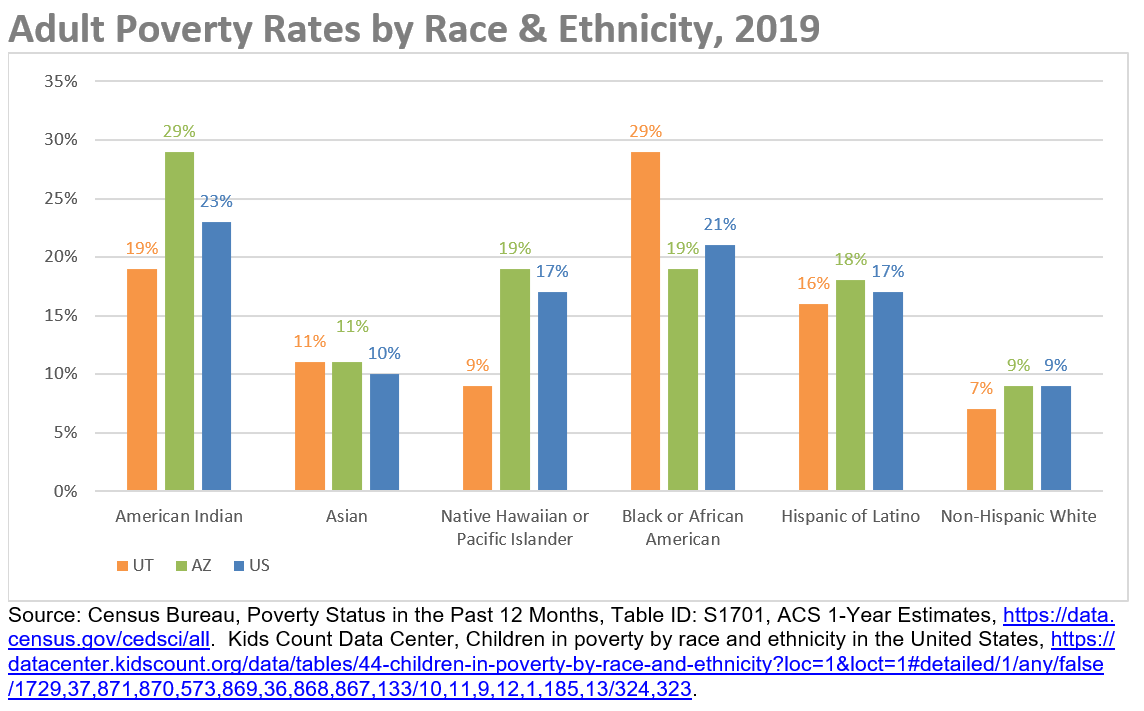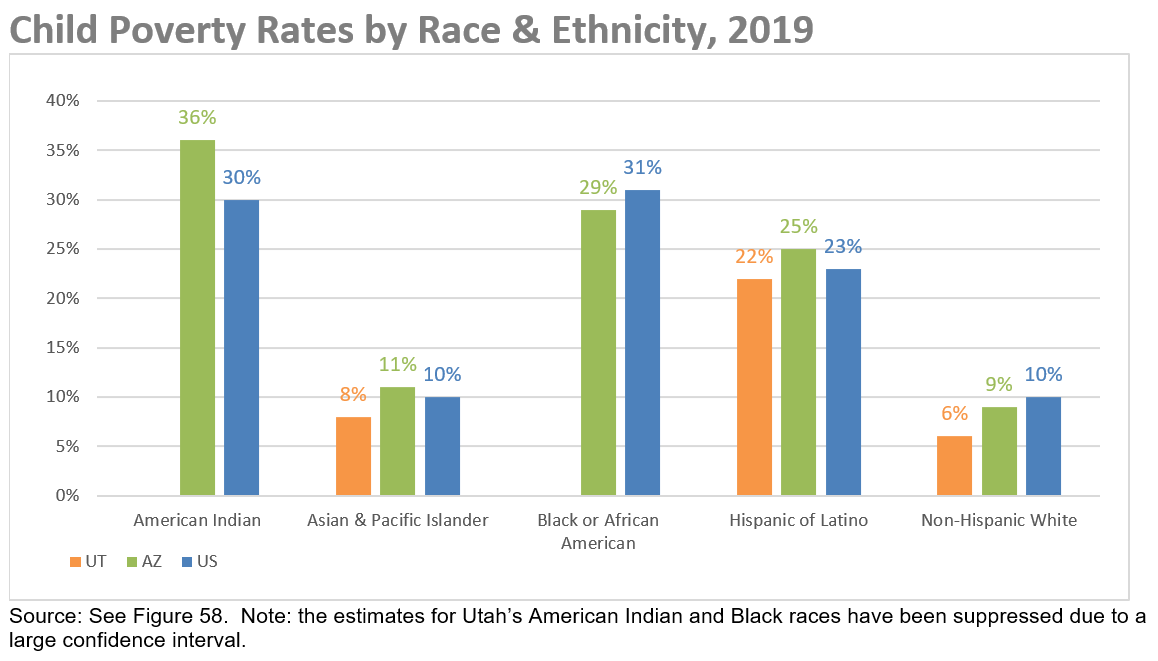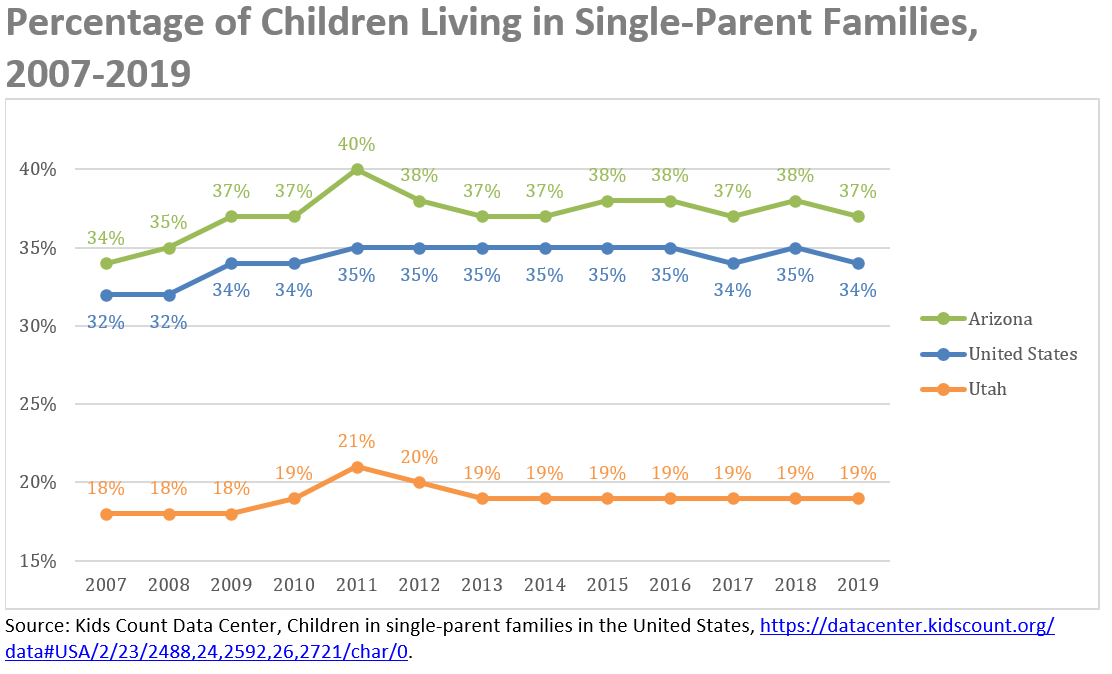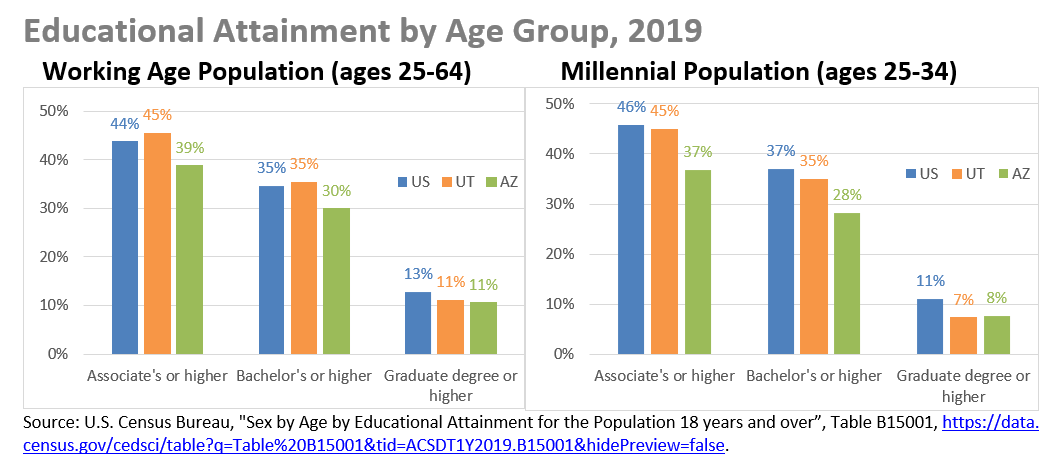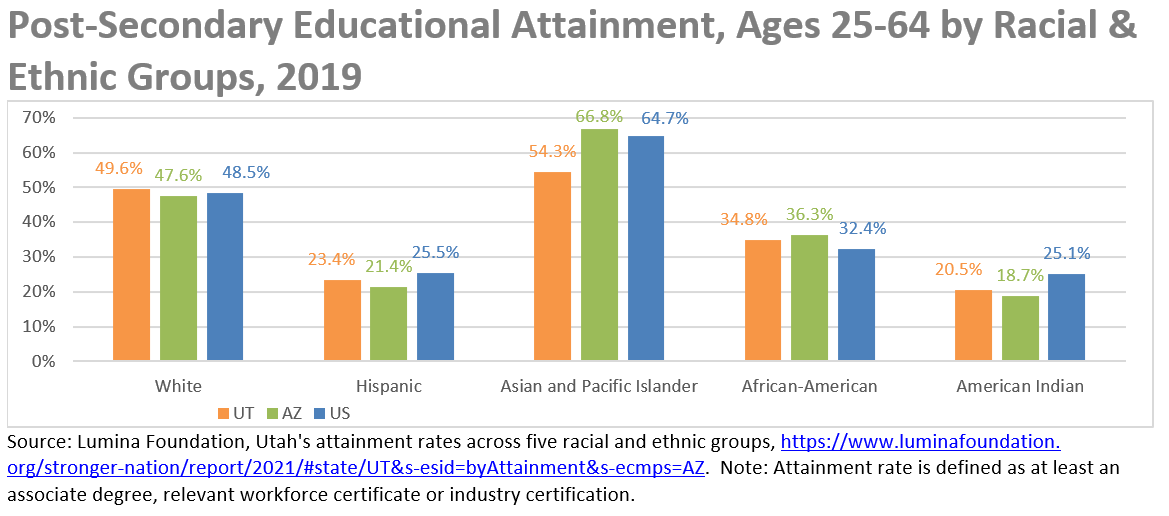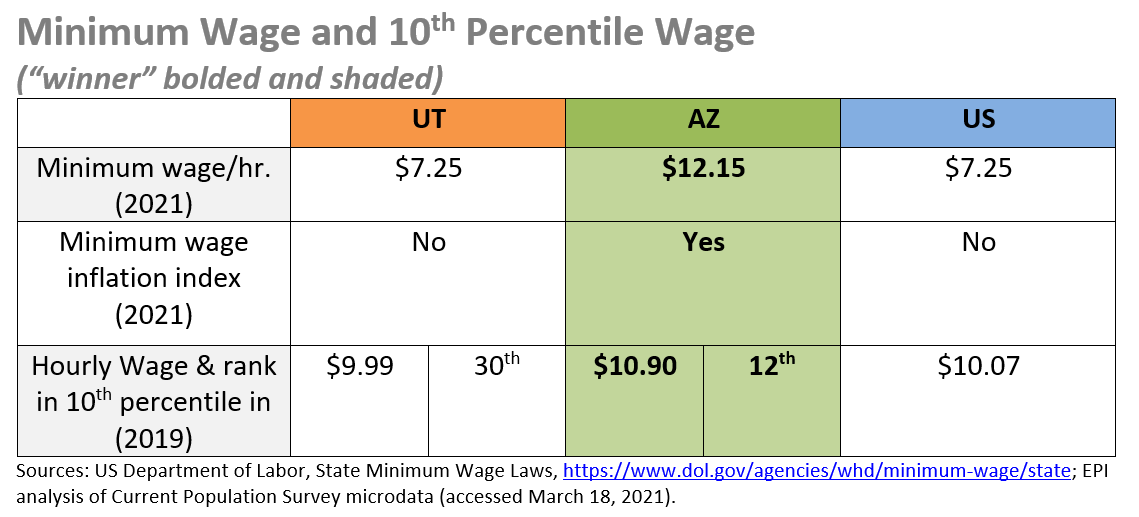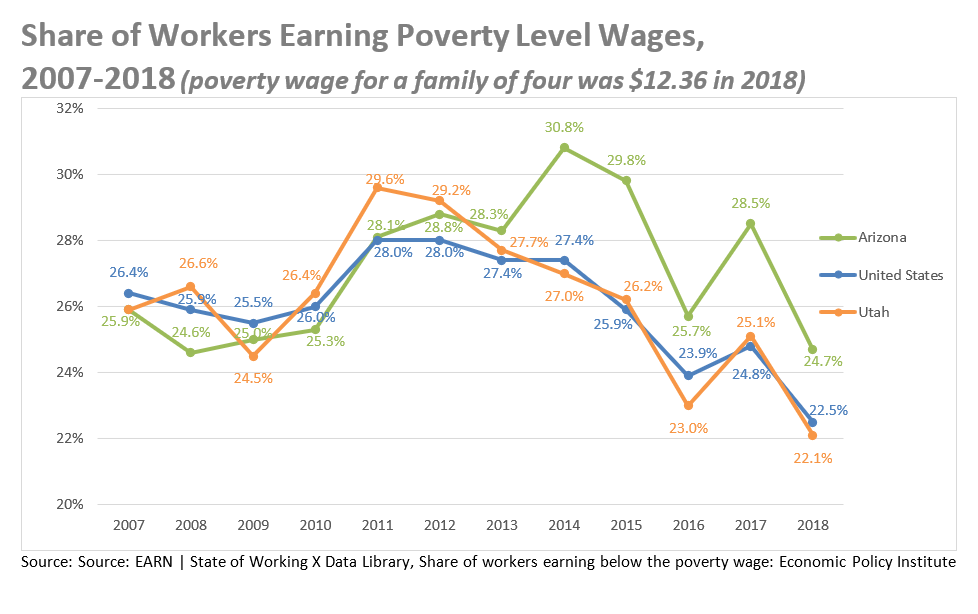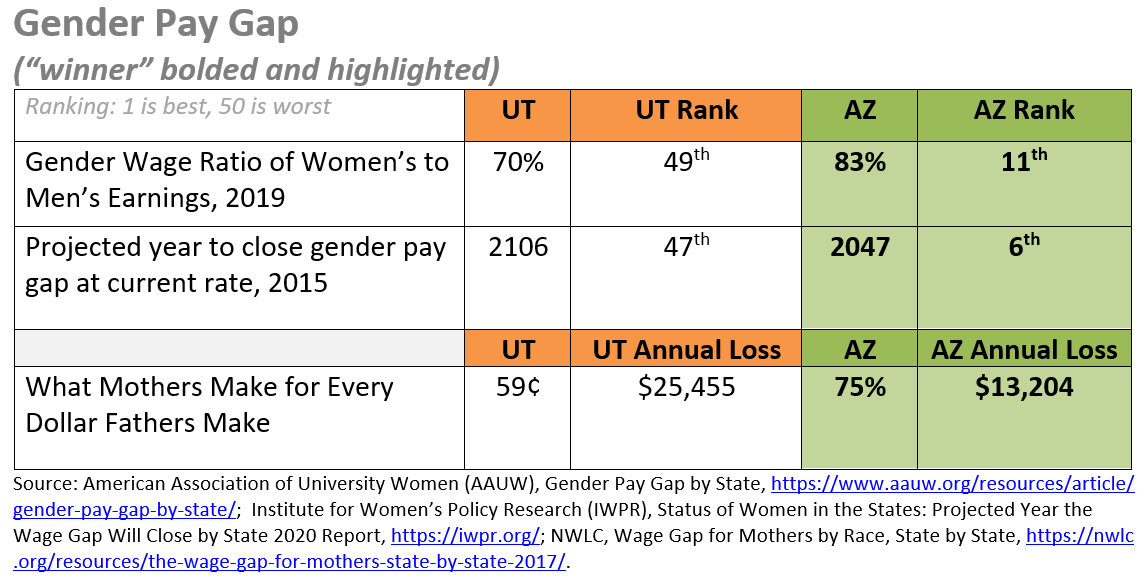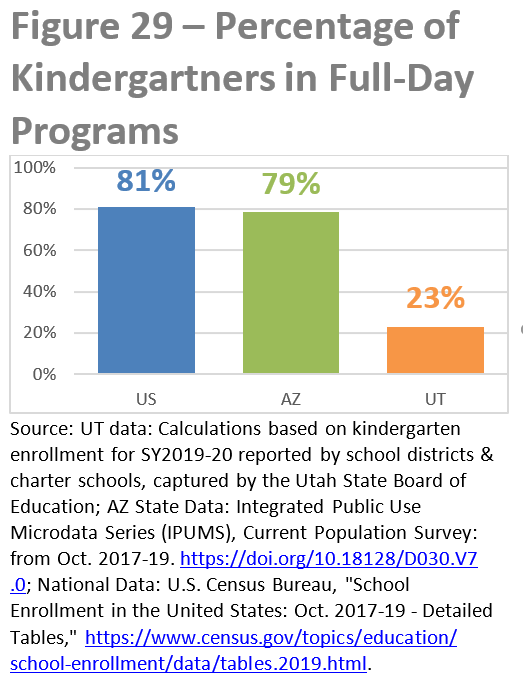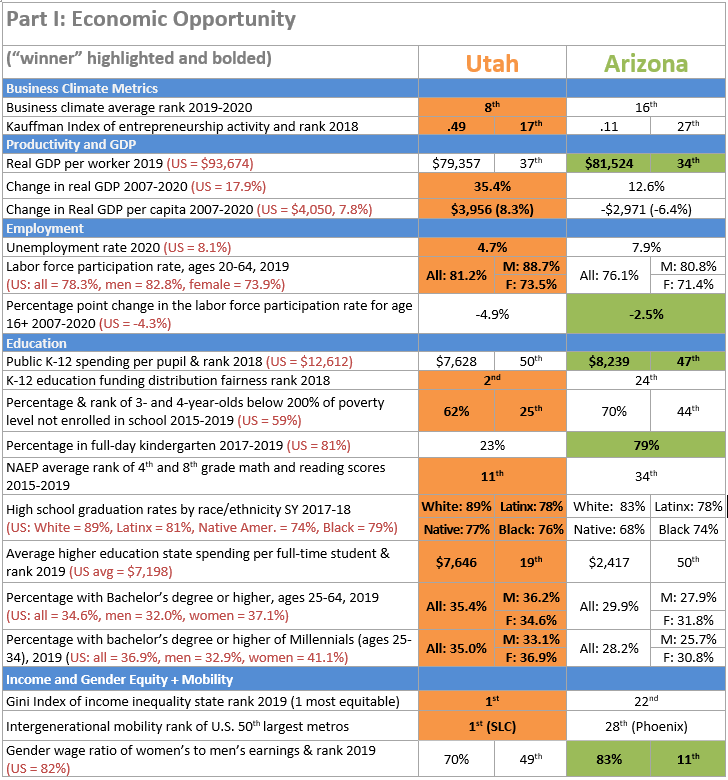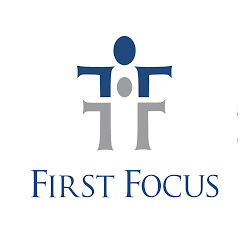Early Education
For too many years, child are policy – in Utah and nationally – has been shaped primarily by economic and political forces. These forces have shaped our perceptions of early care and education: “People need childcare because they should be working. Government shouldn’t invest in childcare because that’s a family problem.”
But economics and politics don’t belong at the center of a well-functioning, family-oriented early care and education system.
Children do.
A child-centered child care system would look very different from the one we have in Utah today. A child-centered early care and education system would be driven by committed and caring providers who are appropriately compensated, and thoughtfully trained, for their invaluable work. It would offer plenty of choice for Utah families seeking a child care setting that complements their values, preferences and cultural backgrounds. Most importantly, such a system would take seriously the intense developmental needs of young children – and enthusiastically work to fulfill those needs for every child, regardless of their family’s monthly income.
This period of great disruption, despite all its challenges and uncertainty, is the perfect moment to reimagine Utah’s child care system. It is well past time for our state to invest in a system that celebrates and acknowledges the critical public good that is early care and education.
In an excellent brief entitled “Complex Considerations for the Recovery of Ohio’s Essential Child Care System,” our colleagues at Groundwork Ohio wrote:
“While it is undisputed that quality child care is essential to reopening the economy so parents can return to work, high quality child care also provides the same critical education to our infants, toddlers and preschoolers year round that our K-12 system provides to our school-age children during the school year – especially when infant and toddler brains are growing more rapidly than any other period of their life.
Similarly, as has been learned during this time, the K-12 system effectively provides child care in addition to a high-quality education when children are at school. Our youngest children will soon be part of the workforce themselves on the other side of this pandemic and deserve access to the opportunities we know will support their healthy development and school readiness, so they too can thrive in our future economy.”
You’ve probably heard that in Utah (as in many other states) a year of child care for an infant can cost a family as much as a year at a public university for a teenager. Well, there’s no reason that shouldn’t be true: early education is the better lifelong investment, both for families and for the government. If Utah families had to pay the true value of early care and education, almost none would be able to afford it.
The COVID19 pandemic has emphasized how integral both child care and public education are to the healthy functioning of our communities. The pandemic has also laid bare the dire long-term consequences of Utah’s underinvestment in both of these areas.
When the legislature makes its flurry of short-sighted budget cuts this summer, our state child care system will escape with less damage than our (pre)K-12 public education system. That’s only because the state has consistently spent on child care programs only the bare minimum necessary to draw down federal funding. There simply isn’t any meaningful state funding to cut from Utah’s child care programs.
Rather than matching federal Child Care and Development Block Grant (CCDBG) and Head Start funding with any state dollars, Utah has been content to settle for whatever we can manage with what Congress decides to give us. The result has been a child care system that has only one-third the necessary capacity to meet the needs of Utah’s working families.
Again, that was the capacity of our pre-pandemic child care system. Currently, only about 86% of those pre-pandemic child care slots are available to Utah families - and without emergency funding through the CARES Act, that figure would be closer to 60%.
During the pandemic, as before, Utah will probably be able to keep our struggling child care sector afloat by relying on federal funding - for the next few months, at least. But “staying afloat” won’t get us any closer to the child-centered child care system Utah families deserve: a stable, diverse system that always puts kids’ needs first. Only increased investment by the state government, with substantial support from the corporate sector, can ensure that infants, toddlers and pre-school aged Utah children get the early care and education they deserve.
Voices for Utah Children Statement: COVID-19 and How the State Of Utah Should Protect Families
On March 11, 2020, Governor Gary Herbert took the necessary step of declaring a state of emergency in Utah in order to address the coronavirus (COVID-19) pandemic. As the state moves forward with immediate activity to address the health implications of this global pandemic, we also urge lawmakers to consider enacting policies that will help mitigate its economic fallout for families and children in Utah.
Health Care
The immediate challenge is to ensure that all Utahns get access to critical health care. No Utahn should be denied access to care or feel afraid to get the care they need. Quickly identifying and treating those who have the virus, while taking all community public health precautions, will enable us to reduce the spread and help to flatten the curve.
We know this pandemic will present unique challenges to Utah’s health care system and to Utah families. In the past two years we have seen one of the largest increases in children lacking health insurance coverage in the nation. This outbreak should remind us that not one of us is truly safe when some of us are vulnerable. We need to immediately create a path for those uninsured children to be provided coverage until this emergency is over.
The state should ensure that the costs of testing and treatment for the coronavirus are fully covered to ensure that all Utah residents can get the care that will protect them, their families and their communities.
In these times, it is also critical that we remove any barriers to care or eligibility, especially for our most vulnerable Utahns. Utah should immediately halt its Medicaid work requirement and new premium payment requirement. At a time of such unprecedented economic change, this will only create additional barriers for families, while enforcement and implementation will waste valuable state resources. The state should suspend other waiver requests to CMS that will further deny care to individuals and families.
In addition, Utah must adopt policies that will ensure children and families can stay covered, which means extending renewal periods, grace periods for returning information and application processing times. This will not only keep families safe, but state eligibility workers as well.
Finally, we call on the state to support outreach and information to help all Utahns feels safe and welcome getting care, and also to provide information about how Utah kids and families can immediately connect with affordable coverage.
In the longer term, we should commit ourselves to covering all children and families in our state, so no one is left without coverage in times like this. And we must work in partnership to strengthen our health care system and our safety net providers, so we are equipped to meet the needs of all children regardless of ethnicity, nationality, immigration status, or where they live in the state. We must ensure families have access to the comprehensive care, including physical, dental, mental and behavioral health care, to ensure all kids can stay on track, stay healthy and thrive.
Family Economic Security
Guaranteeing all workers paid sick leave is a proven way to slow the spread of disease and would disproportionately benefit working families who earn low incomes. We are supportive of the action taken at the federal level on March 19, 2020 (the Families First Coronavirus Response Act or FFCRA) and encourage Utah to take immediate action to publicize the protections provided. Here is an outline of the provisions related to paid sick leave and family/medical leave:
Paid Sick Days for Public Health Emergencies
- Two weeks (or 10 work days) of paid sick leave
- Applies to public employers of all sizes and private employers with fewer than 500 employees
- DOL has discretion to exempt businesses with fewer than 50 employees from providing paid sick days for employees to care for a child whose school or place of care is closed
- DOL has discretion to exempt certain health care providers and emergency responders
- Purposes:
- To obtain a medical diagnosis or care if experiencing symptoms
- To comply with a recommendation from a public health official
- To care for an individual who is self-isolating because of a diagnosis or is experiencing symptoms
- When taken for this purpose, rate of pay is reduced to 2/3
- To care for a child if school or place of care is closed
- When taken for this purpose, rate of pay is reduced to 2/3
- Maximum payment is $511 per day/$5,110 total for self-care, $200 per day/$2,000 total for family care
- Impact on existing policies:
- Sick time under the bill must be made available to workers in addition to any employer provided leave
- Employer cannot require an employee to use accrued time before emergency time
- Employer cannot require an employee to find replacement workers
- The law broadly allows for caregiving for an individual under quarantine due to COVID-19. It does not limit caregiving to certain family members.
- Sunsets on December 31, 2020
Emergency Paid Leave
- Amends the FMLA to allow for paid leave in the event of a public health emergency.
- Purpose:
- The employee is unable to work/telework because the employee’s child's school or place of care is closed, or the child's usual care provider is unavailable, due to a COVID-related public health emergency.
- Family member:
- Son or daughter under age 18
- 12 weeks of job-protected emergency paid leave
- First 10 days may be unpaid
- For subsequent leave, employer must pay employee at 2/3 wage replacement, up to $200 per day and $10,000 total
- Applies to employers with fewer than 500 employees
- DOL has discretion to exempt businesses with fewer than 50 employees
- Available to employees who have been on the job for at least 30 days
- DOL has discretion to exempt certain health care providers and emergency responders
- Employers of health care providers and emergency responders may elect to exclude such employees from this leave
- Job Protection
- Employee has a right to job restoration under the FMLA
- Exception for employers with fewer than 25 employees under certain conditions
- Sunsets on December 31, 2020
Workers who do become unemployed, are furloughed, or have their work hours cut due to business downturns or sickness will be the first to feel the economic pain. We should do all we can to speed up the application process for unemployment insurance and comply with the FFCRA requirements for millions of dollars in federal aid by temporarily providing benefits with no waiting period, waiving employer penalties and job search requirements, and maximizing eligibility levels and benefits so no one is left behind. We should also protect those who face losing their employer-provided health insurance benefits because of an economic downturn.
Utah needs to adopt official language defining “essential services” immediately. Here is a sample of a definition being used by other state agencies:
“Essential services and sectors include but are not limited to food processing, agriculture, industrial manufacturing, feed mills, construction, trash collection, grocery and household goods (including convenience stores), home repair/hardware and auto repair, pharmacy and other medical facilities, biomedical and healthcare, post offices and shipping outlets, insurance, banks, gas stations, laundromats, veterinary clinics and pet stores, warehousing, storage, and distribution, public transportation, and hotel and commercial lodging.”
Another major problem is that our state has a growing homeless population, both sheltered and unsheltered. The unsheltered homeless lack the ability to self-quarantine and do not have regular access to medical care. The homeless will need shelter, medical treatment, and emergency homeless services. Therefore, the state must urgently convert its unused/underused spaces into shelters.
Lastly, we should place a moratorium on all foreclosures and evictions until we lift the state of emergency. No Utah families or individuals should be made homeless because of this crisis.
Young Children
With school and child-care facility closures, and work disruptions, a pandemic presents unique challenges for families with young children. In order to maintain a strong early learning and care system through this pandemic, lawmakers should enact practical policies to ensure that families of preschool-aged children are supported and to protect child-care workers and centers – many of which are small businesses operating on very slim margins – from an economic crisis. School-level reactions to the needs of families with young children – such as continuing to run school-based food programs – are very encouraging. We also need to support families with young children who are not yet school aged, including infants and toddlers, but who continue to have nutritional needs at this time. We recommend that state officials direct food retailers to set aside WIC-approved foods for families participating in that program, while also increasing flexibility for families with regards to food purchased as part of the WIC program.
We are pleased to note that state leaders have adjusted child-care subsidy payment policies to account for this unprecedented strain on our child-care sector. We encourage state and local leaders to invest in a wage supplement program for early childhood care and education provider. Such programs must include not only child-care center workers, but also home-based and family child-care providers. Payment policies should be adjusted so they are based on enrollment of children, rather than attendance. Finally, the state should do an immediate review of all safety net programs statewide and streamline all processes during this crisis.
Food security
In Utah, we have a large number of children that depend on school meals for consistent access to food. Based on our most recent data, 36.1 percent of our children participate in the free and reduced-price school lunch program. As schools in Utah will be closed until at least March 30, the state must take immediate steps to ensure that children enrolled in these meal programs have some other access to the meals they will be missing at school.
The state should also be taking steps to minimize food insecurity including: increasing the state Supplemental Nutrition Assistance Program (SNAP) supplement to provide more benefits for recipients; establishing a food distribution system to provide meals for food-insecure families; extending the certification for the Special Supplemental Nutrition Program for Women, Infants, and Children (WIC) to 60 days; streamlining SNAP by exempting families from certain requirements, such as work or education and training requirements; and lastly, making SNAP application available online, by mail, or telephone.
Juvenile Justice
The current situation demands that we refrain from creating unnecessary groupings of people. To that end, we strongly encourage law enforcement throughout the state to restrict arrests and citations of young people to only those most serious, injurious offenses. With very few exceptions, youth should not be taken to detention centers, as our juvenile justice professionals are already working overtime to maintain the cleanliness and safety of those facilities. In addition, as non-essential court activities have been delayed, a reduction in arrests and citations now will prevent unnecessary overwhelm of the juvenile court system when normal operations come back online.
We also strongly recommend that juvenile justice facility managers - including those who operate official state and county youth facilities, as well as community-based placements such as treatment facilities and group homes, exercise the utmost caution with the young people in their care. At the same time, this caution regarding health and safety must be balanced with an understanding of the need of these youth to maintain connections with their family, friends and loved ones. We encourage flexibility with regards to the use of technology for video and telephone visits while people engage in social distancing at the governor’s recommendation. If this situation should persist past the next two weeks, juvenile justice administrators should consider instituting health-related protocols (such as taking of temperature, monitoring for other symptoms, and issuance of personal protective equipment) that would allow family members and other loved ones to visit youth in custody.
Economy
The Coronavirus Recession has already begun, is going to hit faster than any previous recession, is immune in some ways to traditional stimulus (because social distancing limits government's ability to restore consumer spending before the pandemic is addressed), and states need to act fast to take full advantage of the coming federal actions and make the recession shorter and shallower rather than longer and deeper (such as with inaction and budget cuts).
We must resist the urge to cut expenditures on vital services like education and health care. We have seen first-hand how important these areas have been in the current crisis.
Given the immediate need for support, we believe that this is the time to use a portion of our rainy-day fund. The additional money will help officials respond to the outbreak without jeopardizing commitments lawmakers made to fund important priorities in the recently completed legislative session.
We should look at a tax increase on those most able to afford them and reinvest that revenue into specific areas identified during the crisis. This would be a solid investment in the long-term health and prosperity of our state.
Summary
Given the rapidly evolving nature of this crisis, we recognize that many of the recommendations listed above are currently being discussed at both the state and federal level. We encourage our state leaders to take bold and decisive measures to ensure the health and well-being of all the residents of our great state. The focus of Voices for Utah Children is to advocate on behalf of the children and families of Utah. We will continue to update developments as we receive information. Please feel free to contact me directly with any questions or concerns. I can be reached at .
Moe Hickey
CEO
Voices for Utah Children
Poverty Advocates Tax Reform Letter
Utah Poverty Advocates Call for Fairer Taxes and Restoration of Public Revenues
Salt Lake City - Today (September 26, 2019) at the Utah State Capitol, a group of two dozen non-profit organizations that provide services to and advocate on behalf of Utah's low- and moderate-income population released a letter to the Tax Restructuring and Equalization Task Force. The letter calls on the Task Force to consider the impact on low-income Utahns as they consider tax changes that could, in the worst case scenario, make Utah's tax structure more regressive and less able to generate the revenues needed to make critically important investments in education, public health, infrastructure, poverty prevention, and other foundations of Utah's future prosperity and success.
The text of the letter and the list of signatories appears below (and is accessible as ![]() a pdf at this link):
a pdf at this link):
Open Letter to the Tax Restructuring and Equalization Task Force (TRETF)
Tax Reforms for Low- and Moderate-Income Utahns
September 2019
Dear Senators, Representatives, and Other Members of the TRETF:
We, the undersigned organizations that work with and advocate for low- and moderate-income Utahns, urge you to consider the impact on the most vulnerable Utahns of any tax policy changes that you propose this year.
We urge you to address the two major challenges facing our tax structure as it impacts lower-income Utahns:
1) Utah’s current system of taxation is regressive, in the sense that it requires lower-income Utahns to pay a higher share of their incomes to state and local government than it asks of the highest-income Utahns, even though about 100,000 lower-income Utah households are forced into – or deeper into – poverty by their tax burden every year.
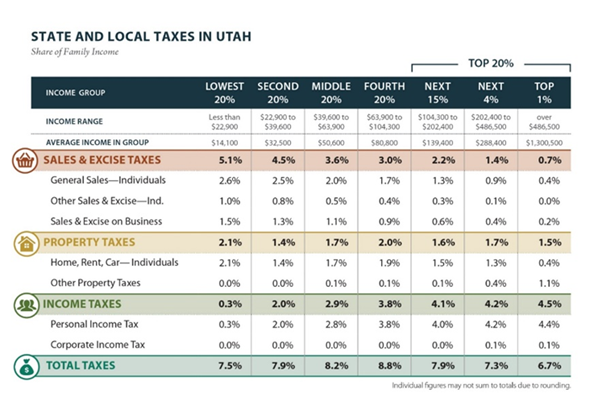
This regressivity could be addressed with tax policy changes including the following:
- A Utah Earned Income Tax Credit (EITC) to allow the working poor to keep more of what they earn.
- Remove the sales tax entirely from food, as 34 other states have done.
- Remove the state income tax on Social Security benefits for low- and moderate-income seniors; Utah is one of only 13 states that tax these benefits.
- Restore the income tax rate to 5% or increase it above that level. (Because the majority of all Utah income is earned by the top quintile of taxpayers, and because the Utah income tax more closely matches Utah’s income distribution than any other tax, most of such an income tax rate increase would be paid by the top-earning 20% of Utahns, while most lower-income Utahns are shielded from income tax rate increases.)
- Disclose and evaluate the effectiveness of tax expenditures (revenue lost to the taxing system because of tax deductions, exemptions, credits, and exclusions); Utah’s lack of transparency in this area of taxation earned us a C grade from the Volcker Alliance, a leading evaluator of state budgetary practices founded by former Federal Reserve chairman Paul Volcker.
2) For decades, Utah’s overall level of taxation relative to the state’s economy has been dropping, as illustrated in the chart below from the Utah State Tax Commission:
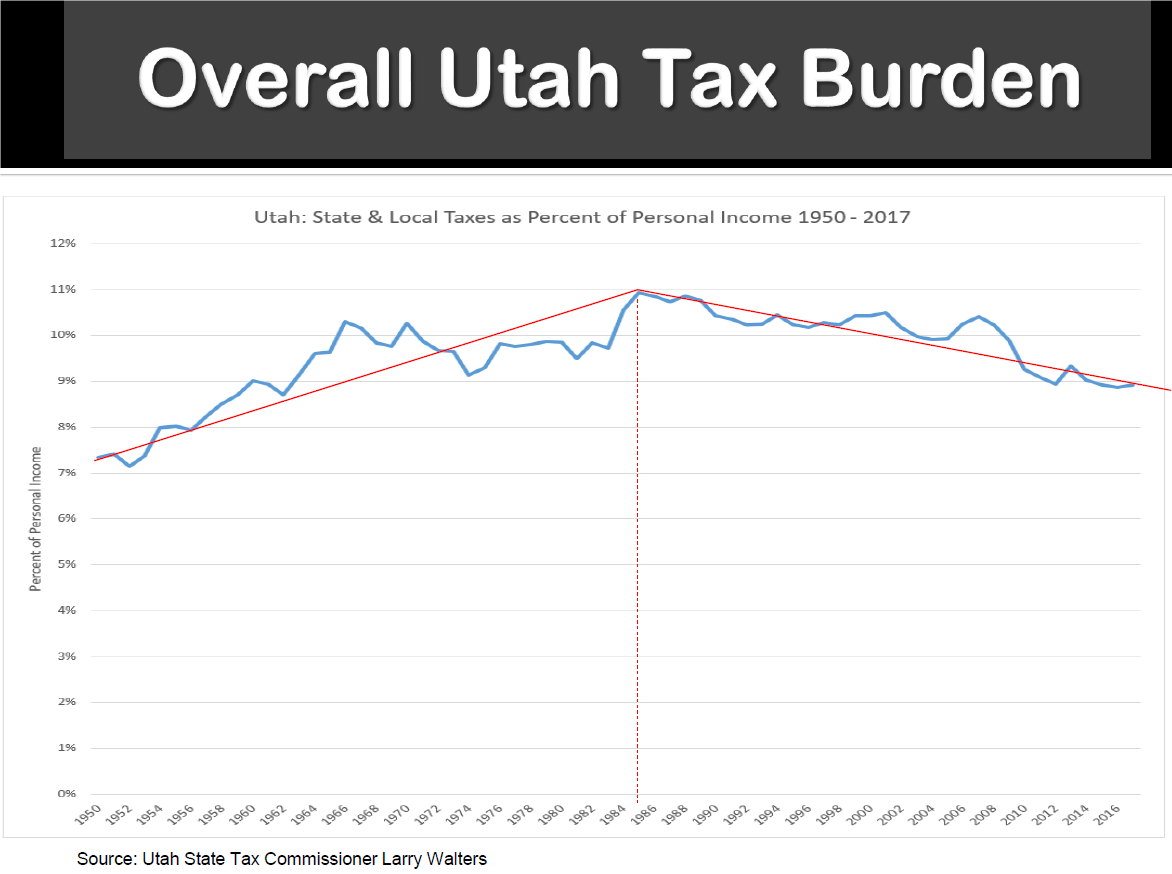
The unfortunate result is that we are left with a tax structure that fails to generate sufficient revenues to allow our state and local governmental entities to properly meet their responsibilities and fulfill their appropriate role in a number of critical areas, including the following:
- Education: Utah ranks last nationally for our per-pupil investment in K-12 education. Particular areas of weakness include:
-
- · Teacher turnover rates are higher than the national average. One study found the majority of new teachers leave within seven years.
- · Pre-K: Utah ranks 36th for our percent of lower-income 3- and 4-year-olds attending pre-school, private or public. We are also 1 of only 7 states not to have statewide public preschool programs. (The state offers only small-scale programs in a limited number of local school districts.) Yet we know from multiple research sources that every dollar invested in high-quality day care and preschools produces at least a $7 return on that investment in future years.
- · Kindergarten: Only a third of Utah kids participate in full-day kindergarten, less than half the national average, because local school districts can’t afford to offer it. Voices for Utah Children estimates that it would cost at least $75 million to offer full-day K to all Utah kids (not including potential capital costs).
- · According to the January 2019 report of the Utah Afterschool Network, the need for after-school programs exceeds the supply many times over, leaving tens of thousands of children completely unsupervised, meaning they are less likely to do their homework and more likely to engage in unsafe activities.
In addition to these input measures, Utah is also lagging behind in terms of several significant educational outcome measures:
-
- · Our high school graduation rates are lower than national averages for nearly every racial and ethnic category, including our two largest, Whites and Latinos.
- · Among Millennials (ages 25-34), our percent of college graduates (BA/BS or higher) lags behind national trends overall and among women.
Moreover, Utah is in the midst of a demographic transformation that is enriching our state immeasurably but also resulting in majority-minority gaps at a scale that is unprecedented in our history. For example, in our education system:
-
- · Our gap between White and Latino high school graduation rates is larger than the national gap.
- · Education Week recently reported that Utah ranks in the worst 10 states for our growing educational achievement gap between haves and have-nots.
- · We are beginning to see concentrations of minority poverty that threaten to give rise to the type of segregation and socio-economic isolation that are common in other parts of the country but that Utah has largely avoided until now.
B. Infrastructure: Utah’s investment has fallen behind by billions of dollars. This is another area where the Volcker Alliance ranked Utah in the worst nine states for failing to track and disclose to the public the dollar value of deferred infrastructure replacement costs. In addition. Internet infrastructure is lacking in some rural counties, limiting their integration into Utah’s fast-growing economy.
C. Mental Health and Drug Treatment: Utah was recently ranked last in the nation for our inability to meet the mental health needs of our communities, according to a recent report from the Kem C. Gardner Policy Institute. Underfunding of drug treatment and mental health services costs taxpayers more in the long run as prison recidivism rates rise because the needed services are not available. Estimates are that Utah meets only 15% of the need for these vital, life-saving services.
D. Affordable housing units fall 41,266 units short of meeting the need for the 64,797 households earning less than $24,600, yet the annual $2.2 million state allocation to the Olene Walker Housing Loan Fund has not changed in over two decades, despite inflation of over 60%. Among extremely low-income renter households, 71% pay more than 50% of their income for housing, which is considered a severe housing burden. This year, the Olene Walker Housing Loan Fund used up most of its annual $14 million budget at its very first meeting of the fiscal year (made up of both state and federal funds).
E. Health care: Our rates of uninsured children are higher than national averages – and rising – especially among the one-in-six of our children who are Latino. In Utah 35,000 or 5% of White children are uninsured (national rank = 36th place), compared to 31,000 or 18% of Latino children (rank = 46th = last place in 2017).
F. Disability services: The 2018 annual report from the Utah Department of Human Services’ Division of Services for People with Disabilities reports that the wait list for disability services grew to a record level of 3,000 individuals last year and that the average time on the wait list is 5.7 years.
G. Seniors: The official poverty measure undercounts senior poverty because it does not consider the impact of out-of-pocket medical expenses. A 2018 study found that seniors spent $5,503 per person on out-of-pocket medical expenses in 2013, making up 41% of their Social Security income. (For most seniors, Social Security is the majority of their income, and it makes up 90% or more of income for 21% of married couples and about 45% of unmarried seniors.)
H. Domestic Violence: Although Utah's overall homicide rate is significantly lower than the national average, domestic-violence-related homicides constitute over 40% of Utah's adult homicides compared to 30% nationally. Several thousand women continue to be turned away annually from crisis shelters because of lack of capacity. Additional state funding would make it possible to substantially increase the capacity of overburdened crisis shelters. We are one of the few states without domestic violence services in every county.
Given the large number of urgent needs that are not being met because of our chronic shortage of public revenues, we are concerned that Utah is missing the opportunity to make critically important upfront investments now that would allow us to reap substantial rewards in the future, and that our most vulnerable neighbors will pay the greatest price as a result.
Thus, we urge you to consider the ways that the state tax structure impacts single parents, disabled adults, low-income children, seniors on fixed incomes, and other vulnerable population groups as you decide on your tax restructuring and equalization proposals.
Finally, thank you for all the time and effort you are personally investing as volunteer members of this important Task Force, and for all that you do for our state through this and other forms of public service.
Yours truly,
|
American Academy of Pediatrics Utah Chap. Catholic Diocese of Salt Lake City Coalition of Religious Communities Community Action Program of Utah Community Development Finance Alliance Community Rebuild |
Comunidades Unidas Crossroads Urban Center Epicenter First Step House League of Women Voters Utah Legislative Coalition for People with Disabilities ICAST Habitat for Humanity of Southwest Utah |
Moab Area Hsg Task Force Provo Housing Authority RESULTS Utah Rocky Mountain CRC Self-Help Homes, Provo, UT Utah Citizens’ Counsel Utah Coalition of Manufactured Homeowners Utah Community Action Utah Food Bank Utah Housing Coalition Utahns Against Hunger Voices for Utah Children |
New Economic Benchmarking Report Finds Utah Ahead of Arizona in Most Key Metrics of Economic Opportunity and Standard of Living
Salt Lake City, May 6, 2021 - Voices for Utah Children released today the fourth in its series of ![]() economic benchmarking reports that evaluate how the Utah economy is experienced by median- and lower-income families by benchmarking Utah against another state. This year's report, authored by Taylor Throne and Matthew Weinstein with support from interns from the University of Utah Department of Economics, compares Utah to its southern neighbor, Arizona. Utah and Arizona have a nearly identical proportion of working age adults (18 to 64 years), increasingly diverse populations, and ready access to outdoor recreational opportunities here in the American Southwest. The findings in this year's report shed light on some of Utah's greatest strengths as well as where we can continue to improve.
economic benchmarking reports that evaluate how the Utah economy is experienced by median- and lower-income families by benchmarking Utah against another state. This year's report, authored by Taylor Throne and Matthew Weinstein with support from interns from the University of Utah Department of Economics, compares Utah to its southern neighbor, Arizona. Utah and Arizona have a nearly identical proportion of working age adults (18 to 64 years), increasingly diverse populations, and ready access to outdoor recreational opportunities here in the American Southwest. The findings in this year's report shed light on some of Utah's greatest strengths as well as where we can continue to improve.
Voices for Utah Children's State Priorities Partnership Director Matthew Weinstein commented, "The main takeaways from this report and the others in the series are that Utah's economic successes put us in a position to make the new upfront investments we need to make now -- in education, public health, poverty prevention, and closing majority-minority gaps -- so that we can achieve our true potential and follow in the footsteps of states like Colorado and Minnesota that have become high-wage states and achieved a higher standard of living, and do it in such a way that all our children can have a better future."
The report release presentation took place online and can be viewed at https://fb.watch/5jZBVxpKOY/ . The presenters included both Taylor Throne and Matthew Weinstein as well as a special guest, David Lujan, Director of the Arizona Center for Economic Progress, to share the Arizona perspective on the report.
Utah's Top Economic Advantages: Hard Work & Strong Families Allow Utah to Enjoy High Household Incomes and Low Poverty
Utah enjoys a higher real median household income than Arizona, ranking #11 nationally, although there are significant gaps between the median wage of different racial and ethnic groups. Utah's higher incomes are due largely to our high labor force participation rates and our preponderance of two-worker (often two-parent) households.
Utah Has Lower Poverty Rates Overall But Still Suffers from Large Racial/Ethnic Gaps
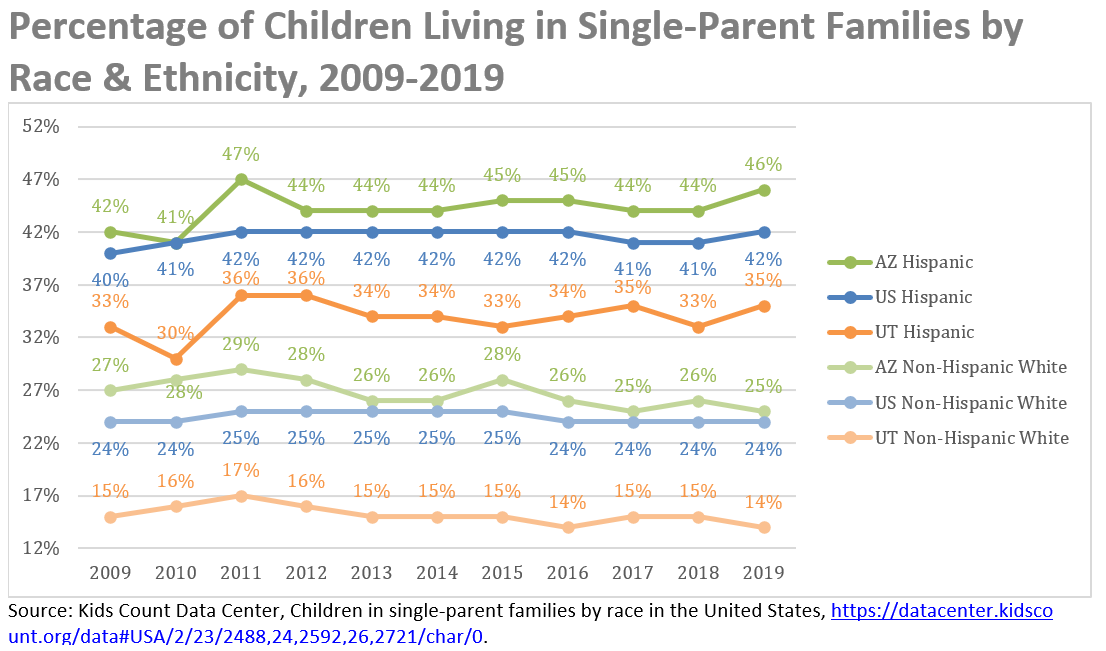
Educational Attainment: Utah Ahead of Arizona But Falling Behind the Nation
The charts below from our latest benchmarking report compare Utah, Arizona and the nation as a whole on educational attainment. Historically Utah was well ahead of the nation, but more recently evidence has mounted that the younger generation of Utahns is not keeping up with the nation's gains at the level of higher education. Moreover, there are stark racial/ethnic gaps in both states and the nation as a whole.
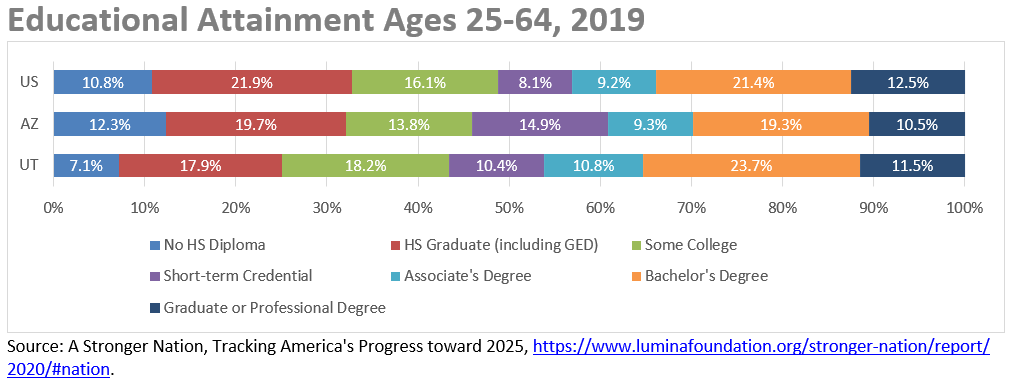
Utah's high school graduation rates are at or below national averages for most racial/ethnic categories, including our two largest groups, Whites and Latinos.
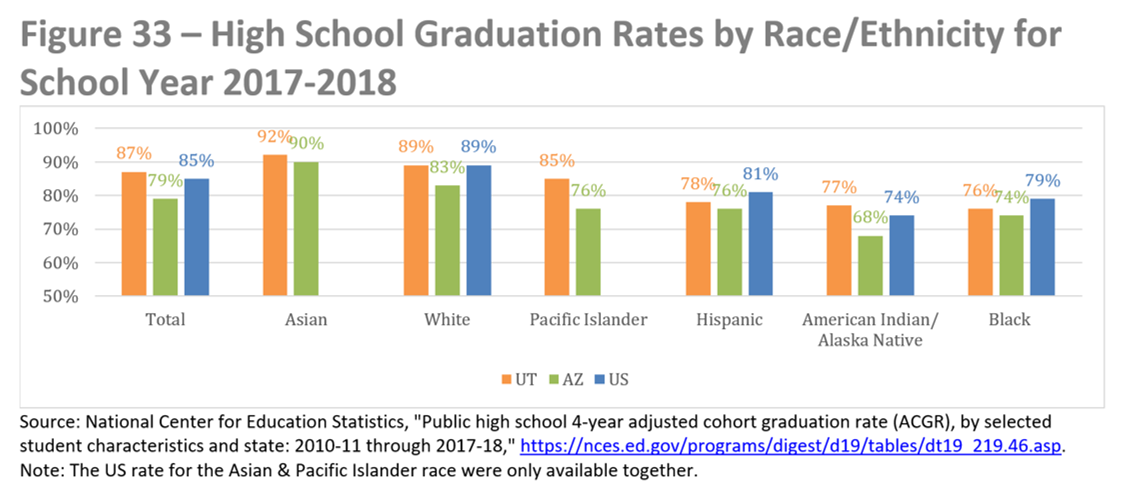
We're also very concerned that Utah's gap between high school graduation rates for Whites and Latinos is larger than nationally.
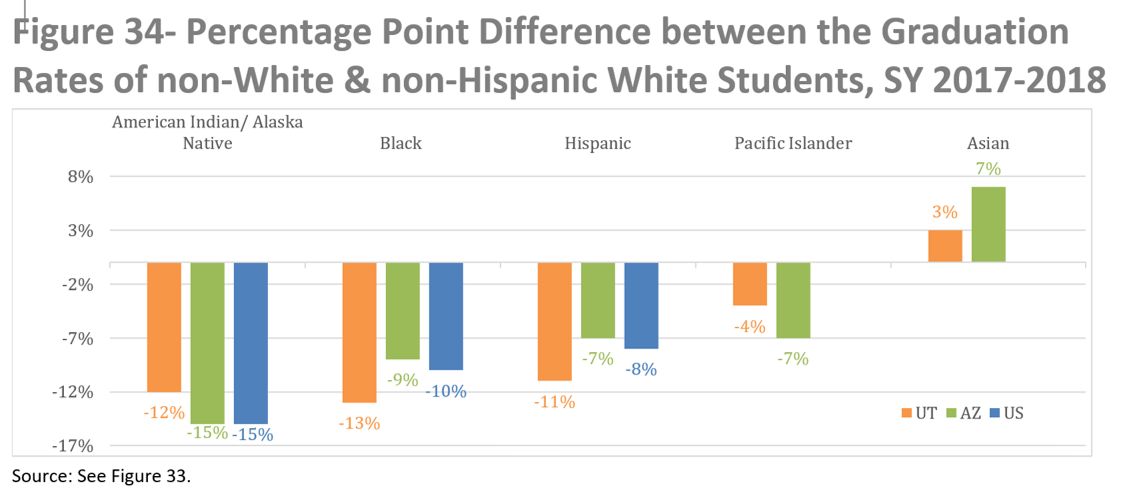
The chart below illustrates the way that Utah's younger generation of adults has fallen behind the higher education attainment of the Millennial generation nationally.
Can Utah Learn Any Lessons from Arizona's Strengths?
Besides Arizona's #11 rank for equal gender wage ratio (while Utah ranks #49), Arizona has more of its children in full-day kindergarten, has a lower 10th percentile hourly wage, and higher productivity. Arizona's higher 10th percentile hourly wage is likely due to their higher minimum wage, although they do have more people earning poverty level wages overall. Meanwhile, Utah has fewer people earning poverty level wages overall, but those at the 10th percentile for hourly wages earn less than their Arizonian counterparts.
Summary of Key Findings
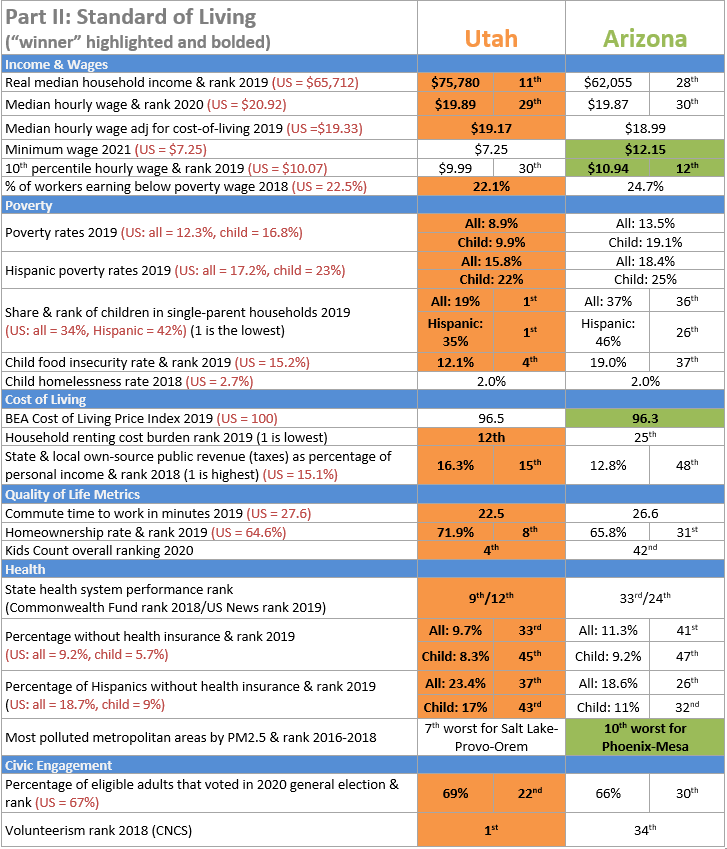
The full 56-page report is ![]() available here as a pdf download.
available here as a pdf download.
Policy Implications
Racial/Ethnic Gaps
Racial and ethnic gaps remain a major challenge in the nation overall, and Utah and Arizona are no exception. Disparities in Utah between minority racial & ethnic groups compared to their White non-Hispanic peers are evident in high school graduation rates, wages, gender pay gaps, poverty rates, and uninsured rates. Addressing these gaps through an upfront investment in education would likely increase educational attainment, wages, and standard of living overall and would therefore contribute to reducing racial and ethnic gaps in the future.
The Link Between Education and Income
The link between education and income is well-established. States with higher education levels generally have higher levels of worker productivity, wages, and incomes. In the current comparison with Arizona, Utah’s higher education levels make for higher levels of wages and income. The lesson for Arizona would be raise education levels to raise the state’s standard of living. The same applies to Utah, where the Legislature has struggled to turn seemingly large dollar increases in education funding every year into increases in real per-pupil investment sufficient to get Utah out of last place in the national ranking.
The latest data from the Census Bureau reports that Utah remains in last place in per-pupil education investment at $7,628, with Arizona only slightly better at $8,239 and 47th in the nation (for FY 2018). While Utah has done well for its meager investment levels, achieving impressive gains in educational performance as measured by NAEP 4th and 8th grade math and reading scores (see Figure 31, page 25), will we be able to continue to advance while remaining in last place?
While Utah “does more with less” in education compared to other states, we have growing challenges to address. Utah has racial/ethnic education gaps which are larger than the national average, for example for Hispanic and American Indian high school graduation rates (see Figure 33, page 26). Utah’s pupil-to-teacher ratio is 22.9, ranking 48th while the national average is 16 (see Figure 22, page 21). Moreover, Utah teacher pay has also fallen over the past 50 years by 1.8% while nationally teacher salaries have increased 6.7% (see figure 24, page 22).
At the college level, Utah historically was always ahead of the national average for attainment of bachelor’s degrees and above. But Census data show Utah’s lead shrinking relative to the nation with each successive generation, to the point now that Utah millennials (ages 25-34) are behind their peers nationally, despite relatively generous state support and low tuition levels.
Can Utah Become a High-Wage State?
For many years, economists have debated whether Utah is a low-wage state, as the Utah Foundation discussed in their 2008 report, “Is Utah Really a Low-Wage State?”[1] That report argued that our seemingly low wages were explained by our younger demographic profile and lower cost of living. While this report does not examine how wages intersect with age demographics, Utah ranks 29th in median hourly wages, compared to 41st in 2004 (see chart below). When adjusted for our low cost of living, Utah’s median hourly wage in 2019 was $19.17, just 16 cents lower than the national level. These data seem to demonstrate that Utah has gone from being a low-wage state a generation ago to middle-wage status today, a considerable accomplishment.

One question Utah leaders may now wish to consider is, is that good enough? Should we declare, “Mission Accomplished”? Or is Utah in a position, like Colorado and Minnesota before us, to become, over time, a high-wage state and set our sights on taking the necessary steps today to achieve that goal over the years and decades to come?
Similarly, how do we include those earning the lowest wages in the gains Utah has made and will potentially make in the future? Utah is not even a half percentage point lower than the national share of workers earning poverty level wages (see Figure 55, page 38) and lags behind the nation’s 10th percentile wage, ranking 30th (see Figure 54, page 37). Even as the state with the lowest income inequality ranking in the nation (see Figure 45, page 31), Utah suffers from a tremendous gap between low-income workers and the rest of the income scale.
The main lesson that emerges from the Working Families Benchmarking Project reports comparing Utah to Colorado, Minnesota, Idaho and now Arizona is the following: Higher levels of educational attainment translate into higher hourly wages, higher family incomes, and an overall higher standard of living. The challenge for policymakers is to determine the right combination of public investments in education, infrastructure, public health, and other critical needs that will enable Utah to continue our progress and achieve not just steady growth in the quantity of jobs, but also a rising standard of living that includes moderate- and lower-income working families from all of Utah’s increasingly diverse communities.
MEDIA COVERAGE OF THE BENCHMARKING PROJECT:
Facebook Live Event discussing the report overall joined by David Lujan, Director of Arizona Center for Economic Progress at Children's Action Alliance: https://fb.watch/68E_JarLMT/
Facebook Live Event focusing on women in higher education, the gender pay gap, and income equality with panelists: Dr. Susan Madsen, Founder and Director of the Utah Women & Leadership Project; Marshall Steinbaum Ph.D., Associate Professor at the University of Utah's department of Economics; and Gabriella Archuleta JPP MPP, Policy Analyst with YWCA Utah. https://fb.watch/68FoEVvGwY/
Facebook Live Event focusing on Utah's economic success and economic development strategy with panelists: Howard Stephenson MPA, former Utah Senator; Phil Dean MS MPA, public finance senior research fellow at the Gardner Institute; and Thomas Maloney PhD., Professor, Department of Economics, University of Utah. https://fb.watch/6r25O5rdDd/
Facebook Live Event focusing on education in Utah from pre-school to higher education, focusing on educational attainment & closing racial and ethnic gaps with panelists: Carrie Mayne, Chief Economist for Utah System of Higher Education; Andrea Rorrer PhD., Director of the University of Utah's Education Policy Center; and Anna Thomas MPA, Senior Policy Analyst at Voices for Utah Children. https://fb.watch/7iKYaR9Zy4/
A Shared Services Alliance for Pre-K
Voices for Utah Children is excited to be involved in several innovative new developments in early childhood education here in Utah. In April, Voices received a second 3-year grant from the Kellogg foundation, which will enable us to continue enhancing and supporting high quality Pre-K through our partnership with Granite School District (GSD) Preschool Services.

Last month, I had the opportunity to tour Sound Child Care Solutions (SCCS), a highly successful shared services model in Seattle, WA. SCCS is a consortium of Early Childhood Education (ECE) providers offering high quality preschool opportunities for children ages 0-5; the alliance includes nine centers across Greater Seattle, with a centralized administrative facility. Some of the centers serve mostly low-income families, while others serve a largely upper-income population. Each center has preserved its own unique culture. Because of the SCCS partnership, however, high program quality is able to be maintained across all nine centers.
 Refugee & Immigrant Family Center Seattle, WAVoices and GSD worked with several private preschool providers across the Salt Lake Valley during the first Kellogg grant project, and a number of these providers have expressed interest in sharing services with one another. Because they already share a deep commitment to providing high quality early education opportunities to the children and families they serve, I am excited and optimistic about the prospect of launching an ECE Shared Services Alliance to better serve more children across the city, the county, and ultimately the state.
Refugee & Immigrant Family Center Seattle, WAVoices and GSD worked with several private preschool providers across the Salt Lake Valley during the first Kellogg grant project, and a number of these providers have expressed interest in sharing services with one another. Because they already share a deep commitment to providing high quality early education opportunities to the children and families they serve, I am excited and optimistic about the prospect of launching an ECE Shared Services Alliance to better serve more children across the city, the county, and ultimately the state.
For 30 years now, Voices for Utah Children has called on our state, federal and local leaders to put children’s needs first. But the work is not done. The children of 30 years ago now have children of their own. Too many of these children are growing up in poverty, without access to healthcare or quality educational opportunities.
How can you be involved?
Make a tax-deductible donation to Voices for Utah Children—or join our Network with a monthly donation of $20 or more. Network membership includes complimentary admission to Network events with food, socializing, and opportunity to meet child advocacy experts. And don't forget to join our listserv to stay informed!
We look forward to the future of Voices for Utah Children and we hope you will be a part of our next 30 years.
Special thanks to American Express for sponsoring our 30th Anniversary Year. 


